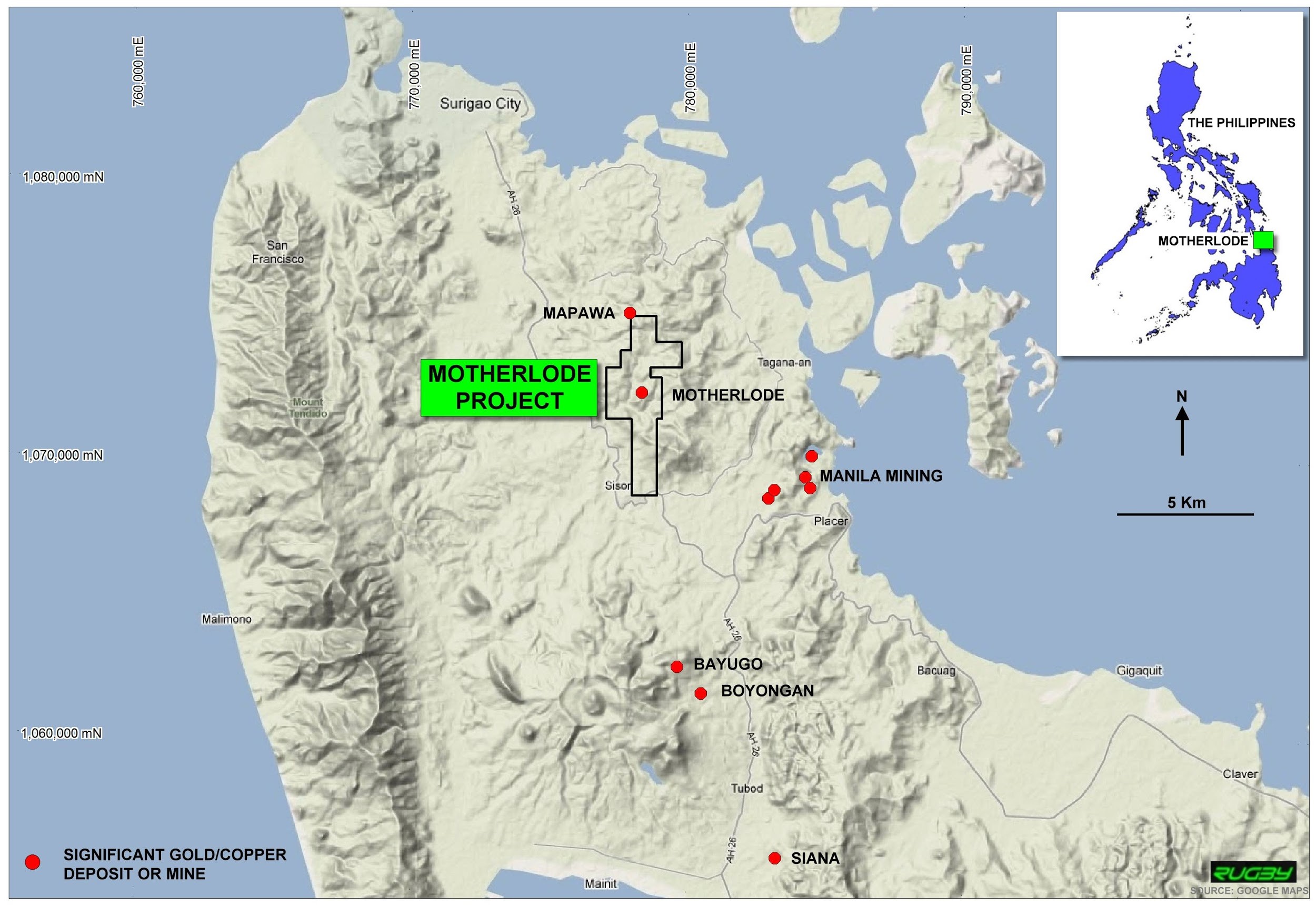Motherlode, PHILIPPINES
The Motherlode Gold-Copper project (“Motherlode” or the “Project”) covers an area of 878 hectares (“ha”) and is located 12 kilometers (“km”) south of Surigao City, the capital city in the province of Surigao del Norte, Philippines. Motherlode, formerly known as “The Mindanao Motherlode Mine” (“Motherlode”) was an epithermal vein style bonanza-grade gold mine that is estimated to have produced and estimated 500,000 ounces of gold from 1937 through to 1953*. Motherlode, which was once one of the Philippines’ highest grade gold producers, is located in the center of the Project’s tenements. On the basis of past drilling, Motherlode has excellent potential for both epithermal vein-style gold and deeper copper-gold porphyry mineralisation.
The Motherlode is situated within a 15 km radius of multi-million ounce gold and gold/copper porphyry deposits and mines, which include Philex Mining Corporation’s Boyongan and Bayugo gold/copper porphyry deposits, and Manila Mining Corporation’s former gold/copper mines.
All-Acacia Resources Inc, Rugby’s local joint venture partner, submitted an Application for an Exploration Permit for the Mabuhay Project, in April 2013. On January 23, 2019, Rugby announced that a drilling and exploration permit was issued for the Project, including the Motherlode gold target. Rugby’s earlier permits, although covering a large area, specifically excluded the old gold mine area and consequently it had previously been unable to drill the Motherlode target.
Past drilling conducted on the Motherlode targeted the epithermal vein system, returning significant results including 15.5m at 5.92g/t gold and 3.9m at 18.11g/t gold. The predominance of iron sulphides (mainly pyrite, with some chalcopyrite) and quartz (crystalline and comb), mostly as veins and vein/breccias, as well as the metal association, including highly anomalous values for Cu, Te, As, Bi and Se indicates formation at deeper crustal levels close to porphyry intrusions, with fluids derived at least in part from a magmatic source. The records are inaccurate with respect to depth and extent of previous high grade mining, making it difficult to target depth extensions with assurance. Old workings extend to depths of +400 meters below surface.
All-Acacia Resources Inc, Rugby’s local joint venture partner, submitted an Application for an Exploration Permit for the Mabuhay Project, in April 2013. On January 23, 2019, Rugby announced that a drilling and exploration permit was issued for the Project, including the Motherlode gold target. Rugby’s earlier permits, although covering a large area, specifically excluded the old gold mine area and consequently it had previously been unable to drill the Motherlode target.
Past drilling conducted on the Motherlode targeted the epithermal vein system, returning significant results including 15.5m at 5.92g/t gold and 3.9m at 18.11g/t gold. The predominance of iron sulphides (mainly pyrite, with some chalcopyrite) and quartz (crystalline and comb), mostly as veins and vein/breccias, as well as the metal association, including highly anomalous values for Cu, Te, As, Bi and Se indicates formation at deeper crustal levels close to porphyry intrusions, with fluids derived at least in part from a magmatic source. The records are inaccurate with respect to depth and extent of previous high grade mining, making it difficult to target depth extensions with assurance. Old workings extend to depths of +400 meters below surface.
Rugby conducted a limited drilling programme in 2011 on secondary targets, which surrounded the prime Motherlode target area which at the time remained under application. The drilling results, together with earlier geophysical surveying anomalies strongly vectored epithermal gold and porphyry copper-gold potential to the main Motherlode area.
Rugby commenced drilling both extensions to the epithermal vein system and a deeper porphyry target indicated by a significant two kilometer Induced Polarisation anomaly. Rugby’s MD009 intersected 584 m of porphyry mineralisation from immediately below the mine workings at 343 m to the hole bottom at 928 m. The grade was 0.62 g/t gold equivalent (see table below). The intercept included a wide zone of diorite porphyry and argillically altered tuff averaging 0.3 g/t gold, 0.3% copper and 64 g/t molybdenum. Copper and molybdenum values increased with depth coinciding with higher IP chargeabilities.
The Company is encouraged by this early drilling, as the very large porphyry target was validated, and the higher grade potassic zone may potentially occur below the broad mineralized porphyry zone intersected.
Our geophysical experts have suggested that it is very difficult to discern the better targets within this broad, deep IP two kilometer long target, and that Magneto Tellurics (MT) may be better able to define the better targets at depth.
Certain information contained herein can be considered forward Looking. Please click here to review the Company's cautionary statement for investors. Paul Joyce, the Company’s COO, Director and a “qualified person” within the definition of that term in NI 43-101, has supervised the preparation of the technical information contained on this webpage.
*This historical estimate is presented for reference purposes only. A majority of the records on actual ore produced at Motherlode were destroyed during WW2 and by later fires. Management has examined physical evidence at the site and available geological data to confirm that the estimation is suitable for presentation.
**The Company will be required to carry out a further assessment of previous exploration results, including drilling, conducted by the previous operator. The Company believes the data are suitable to report in this news release for informational reference only.





